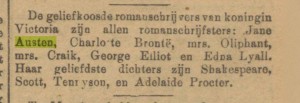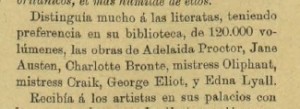The two-day knowledge exchange workshop Women’s History: Research, Dissemination and the role of the Digital (Huygens Institute, 29-30 September, 2015) featured many speakers who talked about travelling texts, but ironically it was during one of the first talks, about library digital initiatives, that evidence of a travelling text was discovered. Arno Kuipers, of the KB National Library of the Netherlands, was describing how the institution was working towards “Linked Data” and “Named entities”: names printed in digitized full text, already recognised by OCR software, can be linked to the authority file about persons in the library’s catalogue, or to international authority files. This would give the researcher an instant way to find out reliable information about a name s/he chanced upon in a text, and these metadata links would also cross-reference other instances of the author’s name appearing in the remaining corpus. Such a facility would be priceless to a researcher tasked with trying to find evidence of an author’s reception in what now amount to over ten million digitised pages of the library. To illustrate this idea, Arno used the following graphic of a piece of text, taken from the digitised Dutch newspaper Algemeen Handelsblad, of June 1st 1897.
Although I don’t have any capacity in the Dutch language myself, I recognised this particular list of women writers as printed as something I had seen in fuller Spanish text, written by a Spanish woman author, Concepción Gimeno de Flaquer, in her magazine El Álbum Ibero-americano:
What is interesting is that the Dutch text, which is an isolated paragraph about Queen Victoria’s library, stands alone as a topic in the newspaper, whereas the Spanish paragraph is part of a much larger article about Queen Victoria, forming more than a magazine page of solid text, and from its style appears to have been written by Gimeno de Flaquer herself (as opposed to translated, as Gimeno de Flaquer did also translate French texts). However, the Spanish article, found Gimeno de Flaquer’s magazine El Album Ibero-Americano, dates from the 7th April 1901, so unless it is reproduced from an earlier text (a possibility as this writer and editor regularly recycled her own work), then both countries’ journalists have used this factual paragraph, in a slightly different format, for their own ends. While the exact relationship between the two is unknown, it was most gratifying to identify a piece of text which linked two of the project countries, entirely coincidentally, so early in proceedings!

